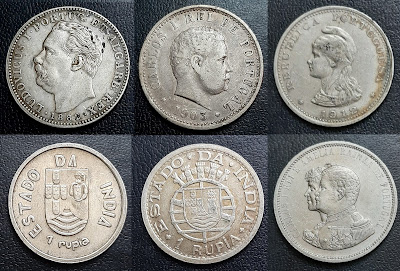The Portuguese were the first European power to reach India - in 1498 and the last to leave, when they were evicted by the Indian armed forces in 1961. While a wide range of coins was minted and issued by Goa, Daman and Diu mints over this period, the best known (and most affordable!) Indo-Portuguese coins are the ones minted after 1881.
In 1878, the Anglo-Portuguese treaty was signed - an economic alliances between England and Portugal with respect to their colonies in India. A uniform currency was adopted to facilitate trade between the two colonial empires. As a result, the Portuguese Rupia was made equal to the Indian Rupee - the two coins were identical in size (11.66 grams) and silver content (0.917 - 91.7%). The designs were also similar, with the head of the respective monarch on the obverse.
The first Uma Rupia coins were minted in 1881, in the name of Luiz 1 - along with smaller fractions in silver - Meia (1/2) Rupia, Quarto (1/4) Rupia and Oitavo (1/8) Rupia. The smaller coins were the equivalent of half rupee, 1/4 rupee and 2 anna coins of British India, which were also silver. Other than this, there was the Tanga, equal to the British Indian anna, with coins of 1/4 tanga, 1/8 tanga and 1/12 tanga in common circulation.
The next series was minted in 1903 and 1904 - under the next ruler of Portugal - Carlos 1. In 1908, Carlos and his heir apparent were both assassinated and soon after, Portugal became a republic. This change was reflected in the coins as well - with the head of liberty replacing the head of the ruler, and the words 'Republica Portuguesa' appearing on the coins. The next change in design was in 1935 - when the head of liberty was replaced by the shield of Portugal. In 1947, the silver content of these coins was cut down to 50% - belated reflection of the reduction of silver content in British India coins in 1940. This was also the last set of Portuguese coins to be minted in silver. In 1958, the Rupia was replaced by the Escudo - at the rate of 6 Escudo to 1 Rupia. The Escudo was used only for a short while - up to 1961, at which point India militarily expelled Portugal from its colonies.
Because Portugal's colonial presence in India was much smaller than the British, the number of coins minted was also much smaller. For instance, just 800,000 coins of Uma Rupia were minted for 1881 and1884. As a result, Indo-Portuguese coins are much rarer (and pricier) compared to coins of British India. However, compared to the rarer coins of British India, such as 1897 rupee, 1939 rupee etc, they are still very affordable to a collector.





